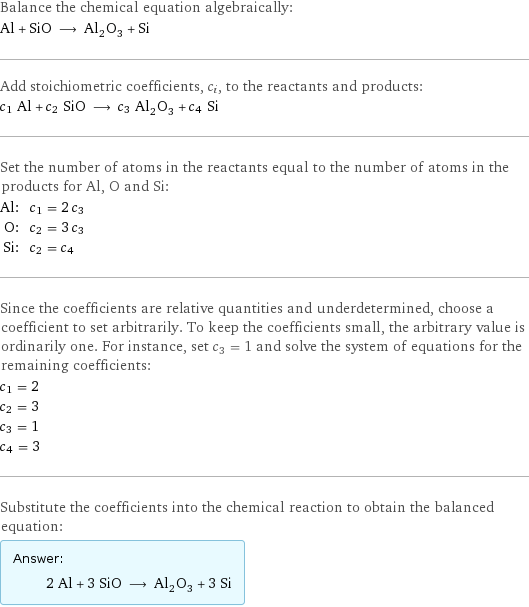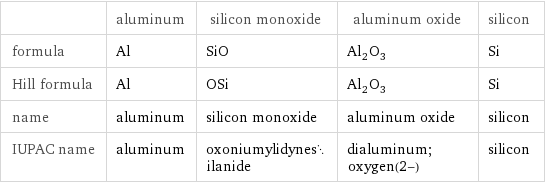Input interpretation

Al aluminum + SiO silicon monoxide ⟶ Al_2O_3 aluminum oxide + Si silicon
Balanced equation

Balance the chemical equation algebraically: Al + SiO ⟶ Al_2O_3 + Si Add stoichiometric coefficients, c_i, to the reactants and products: c_1 Al + c_2 SiO ⟶ c_3 Al_2O_3 + c_4 Si Set the number of atoms in the reactants equal to the number of atoms in the products for Al, O and Si: Al: | c_1 = 2 c_3 O: | c_2 = 3 c_3 Si: | c_2 = c_4 Since the coefficients are relative quantities and underdetermined, choose a coefficient to set arbitrarily. To keep the coefficients small, the arbitrary value is ordinarily one. For instance, set c_3 = 1 and solve the system of equations for the remaining coefficients: c_1 = 2 c_2 = 3 c_3 = 1 c_4 = 3 Substitute the coefficients into the chemical reaction to obtain the balanced equation: Answer: | | 2 Al + 3 SiO ⟶ Al_2O_3 + 3 Si
Structures

+ ⟶ +
Names

aluminum + silicon monoxide ⟶ aluminum oxide + silicon
Equilibrium constant
![Construct the equilibrium constant, K, expression for: Al + SiO ⟶ Al_2O_3 + Si Plan: • Balance the chemical equation. • Determine the stoichiometric numbers. • Assemble the activity expression for each chemical species. • Use the activity expressions to build the equilibrium constant expression. Write the balanced chemical equation: 2 Al + 3 SiO ⟶ Al_2O_3 + 3 Si Assign stoichiometric numbers, ν_i, using the stoichiometric coefficients, c_i, from the balanced chemical equation in the following manner: ν_i = -c_i for reactants and ν_i = c_i for products: chemical species | c_i | ν_i Al | 2 | -2 SiO | 3 | -3 Al_2O_3 | 1 | 1 Si | 3 | 3 Assemble the activity expressions accounting for the state of matter and ν_i: chemical species | c_i | ν_i | activity expression Al | 2 | -2 | ([Al])^(-2) SiO | 3 | -3 | ([SiO])^(-3) Al_2O_3 | 1 | 1 | [Al2O3] Si | 3 | 3 | ([Si])^3 The equilibrium constant symbol in the concentration basis is: K_c Mulitply the activity expressions to arrive at the K_c expression: Answer: | | K_c = ([Al])^(-2) ([SiO])^(-3) [Al2O3] ([Si])^3 = ([Al2O3] ([Si])^3)/(([Al])^2 ([SiO])^3)](../image_source/6db7f7b49d5b974ad22eeacb8b293c07.png)
Construct the equilibrium constant, K, expression for: Al + SiO ⟶ Al_2O_3 + Si Plan: • Balance the chemical equation. • Determine the stoichiometric numbers. • Assemble the activity expression for each chemical species. • Use the activity expressions to build the equilibrium constant expression. Write the balanced chemical equation: 2 Al + 3 SiO ⟶ Al_2O_3 + 3 Si Assign stoichiometric numbers, ν_i, using the stoichiometric coefficients, c_i, from the balanced chemical equation in the following manner: ν_i = -c_i for reactants and ν_i = c_i for products: chemical species | c_i | ν_i Al | 2 | -2 SiO | 3 | -3 Al_2O_3 | 1 | 1 Si | 3 | 3 Assemble the activity expressions accounting for the state of matter and ν_i: chemical species | c_i | ν_i | activity expression Al | 2 | -2 | ([Al])^(-2) SiO | 3 | -3 | ([SiO])^(-3) Al_2O_3 | 1 | 1 | [Al2O3] Si | 3 | 3 | ([Si])^3 The equilibrium constant symbol in the concentration basis is: K_c Mulitply the activity expressions to arrive at the K_c expression: Answer: | | K_c = ([Al])^(-2) ([SiO])^(-3) [Al2O3] ([Si])^3 = ([Al2O3] ([Si])^3)/(([Al])^2 ([SiO])^3)
Rate of reaction
![Construct the rate of reaction expression for: Al + SiO ⟶ Al_2O_3 + Si Plan: • Balance the chemical equation. • Determine the stoichiometric numbers. • Assemble the rate term for each chemical species. • Write the rate of reaction expression. Write the balanced chemical equation: 2 Al + 3 SiO ⟶ Al_2O_3 + 3 Si Assign stoichiometric numbers, ν_i, using the stoichiometric coefficients, c_i, from the balanced chemical equation in the following manner: ν_i = -c_i for reactants and ν_i = c_i for products: chemical species | c_i | ν_i Al | 2 | -2 SiO | 3 | -3 Al_2O_3 | 1 | 1 Si | 3 | 3 The rate term for each chemical species, B_i, is 1/ν_i(Δ[B_i])/(Δt) where [B_i] is the amount concentration and t is time: chemical species | c_i | ν_i | rate term Al | 2 | -2 | -1/2 (Δ[Al])/(Δt) SiO | 3 | -3 | -1/3 (Δ[SiO])/(Δt) Al_2O_3 | 1 | 1 | (Δ[Al2O3])/(Δt) Si | 3 | 3 | 1/3 (Δ[Si])/(Δt) (for infinitesimal rate of change, replace Δ with d) Set the rate terms equal to each other to arrive at the rate expression: Answer: | | rate = -1/2 (Δ[Al])/(Δt) = -1/3 (Δ[SiO])/(Δt) = (Δ[Al2O3])/(Δt) = 1/3 (Δ[Si])/(Δt) (assuming constant volume and no accumulation of intermediates or side products)](../image_source/47f6514c38ed698f67fda45537dea48d.png)
Construct the rate of reaction expression for: Al + SiO ⟶ Al_2O_3 + Si Plan: • Balance the chemical equation. • Determine the stoichiometric numbers. • Assemble the rate term for each chemical species. • Write the rate of reaction expression. Write the balanced chemical equation: 2 Al + 3 SiO ⟶ Al_2O_3 + 3 Si Assign stoichiometric numbers, ν_i, using the stoichiometric coefficients, c_i, from the balanced chemical equation in the following manner: ν_i = -c_i for reactants and ν_i = c_i for products: chemical species | c_i | ν_i Al | 2 | -2 SiO | 3 | -3 Al_2O_3 | 1 | 1 Si | 3 | 3 The rate term for each chemical species, B_i, is 1/ν_i(Δ[B_i])/(Δt) where [B_i] is the amount concentration and t is time: chemical species | c_i | ν_i | rate term Al | 2 | -2 | -1/2 (Δ[Al])/(Δt) SiO | 3 | -3 | -1/3 (Δ[SiO])/(Δt) Al_2O_3 | 1 | 1 | (Δ[Al2O3])/(Δt) Si | 3 | 3 | 1/3 (Δ[Si])/(Δt) (for infinitesimal rate of change, replace Δ with d) Set the rate terms equal to each other to arrive at the rate expression: Answer: | | rate = -1/2 (Δ[Al])/(Δt) = -1/3 (Δ[SiO])/(Δt) = (Δ[Al2O3])/(Δt) = 1/3 (Δ[Si])/(Δt) (assuming constant volume and no accumulation of intermediates or side products)
Chemical names and formulas

| aluminum | silicon monoxide | aluminum oxide | silicon formula | Al | SiO | Al_2O_3 | Si Hill formula | Al | OSi | Al_2O_3 | Si name | aluminum | silicon monoxide | aluminum oxide | silicon IUPAC name | aluminum | oxoniumylidynesilanide | dialuminum;oxygen(2-) | silicon
Substance properties

| aluminum | silicon monoxide | aluminum oxide | silicon molar mass | 26.9815385 g/mol | 44.084 g/mol | 101.96 g/mol | 28.085 g/mol phase | solid (at STP) | solid (at STP) | solid (at STP) | solid (at STP) melting point | 660.4 °C | 1702 °C | 2040 °C | 1410 °C boiling point | 2460 °C | 1880 °C | | 2355 °C density | 2.7 g/cm^3 | 2.13 g/cm^3 | | 2.33 g/cm^3 solubility in water | insoluble | insoluble | | insoluble surface tension | 0.817 N/m | | | dynamic viscosity | 1.5×10^-4 Pa s (at 760 °C) | | | odor | odorless | | odorless |
Units
